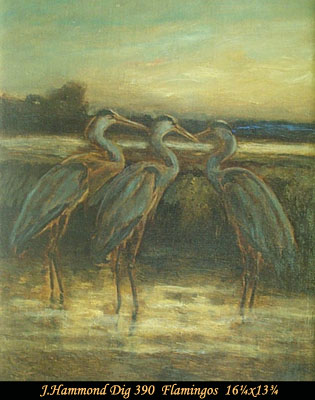|
La vie de certains tient plus du roman que de la biographie. C’est
le cas de John Hammond, né à Montréal en 1843, qui a vécu près d’un
siècle tout en peignant une multitude de tableaux et en parcourant
la terre en tous sens. Sa manière de vivre et les nombreux endroits
qu’il a visités font qu’il est impossible de considérer son œuvre
sans évoquer ses pérégrinations.
Suivant la tradition, toujours vivace, la plupart de nos artistes
allaient en
Europe (c’est toujours l’Europe
ou encore New-York) pour parfaire leur instruction. Ce que firent
Lyman, Franchère, Borduas, Morrice, Suzor-Côté, pour n’en nommer que
quelques-uns. Tout ce monde-là est sédentaire comparé à
Hammond.
À l’âge de neuf ans,
Hammond travaillait déjà pour son père, marbrier, à qui il répugnait
d’engager des mains étrangères. À 11 ans, notre homme décide qu’il
serait artiste-peintre. Deux ans plus tard, il s’engage dans un
régiment surnommé « Les favors de ces dames » pour aller combattre
les Fenians, membres de la Fraternité Irlandaise républicaine aux
Etats-Unis, qui luttaient pour l’indépendance de l’Irlande et
s’attaquaient à l’Angleterre via le Canada…
Quelques mois plus tard, il part pour Londres, accompagné de son
frère cadet, à bord du Peruvian. Il y demeure un temps, puis
s’embarque sur le voilier Mermaid à destination de la Nouvelle-Zélande.
Le voyage dure quatre mois! Ce qui les attirait, lui et son frère,
c’était une « ruée vers l’or », le pays étant censé regorger de ce
métal précieux. Arrivés à
Christchurch, les deux frères marchèrent sur une distance de près de
200 kilomètres jusqu’au fictif Eldorado.
En 1869, après deux ans et demi de labeur sans profit, notre épris
d’aventures prit le bateau pour revenir à Montréal. Mais ce ne fut
pas pour longtemps, ayant à nouveau des fourmis dans les jambes. Il
travaillait chez Notman, le célèbre photographe de la Métropole, où
il transformait des photographies en petits tableaux en y ajoutant
de la couleur. Or, les Service d’études géologiques du
Canada cherchait des hommes pour faire de la recherche afin de
construire une voie ferrée entre l’Ontario et le Pacifique, et
s’était adressé à Notman. Ce dernier lui en fournit deux :
Hammond
fut choisi à titre d’assistant de Benjamin Baltzly. |
 |
|
Hammond
redevient pèlerin. Il parcourt le Japon, toujours armé de sa
palette. Un jour, après avoir reçu une commande du
Canadien Pacifique,
il part pour Londres afin d’y exécuter une murale dans les bureaux
de cette entreprise. L’année suivante, il s’installe à St-John,
N.B., où il a été nommé directeur de la Owens Art Institute.
Naturellement, et sans doute à cause de l’influence de Whistler,
il
peint des scènes de port, de bateaux de pêche et de marines aux tons
embués. Le port de St-John est à lui ce que Venise était pour
Whistler.
Bien que peu connu des Québécois,
Hammond avait une solide réputation auprès des milieux anglophones.
Nommer quelques-uns de ses contemporains – Harry Rosemberg, Edward
John Russell, etc.-, c’est faire allusion a une génération presque
oubliée. Il reste que Hammond était devenu, en 1890, à l’âge de 47
ans, membre de l’académie royale des arts du Canada et qu’il dirigea
pendant longtemps la Owens Art Institute, laquelle devint une
faculté de l’Université Mount Allison, à Sackville, N.B., en 1907.
C’est dans cette ville que
Hammond
passe le reste de ses jours, et où il est mort en 1939 à l’âge de 96
ans.
La production de
Hammond est abondante. On retient surtout ses paysages de
l’hémisphère boréal, qui vont des Rocheuses et de la côte Atlantique
aux campagnes d’Asie, en passant par la Hollande et ses moulins,
l’Italie – Venise, Veron, etc. -, la France champêtre et plusieurs
pays aux couleurs particulières.
Les paysages de
Hammond sont pleins de grands espaces et constituent de magnifiques
études des variations de la lumière du jour rendues avec finesse et
minutie. L’eau et tout ce qui s’y rattache y jour un rôle essentiel,
ce qui se traduit par d’exquis dégradés et par des teintes presque
évanescentes. On peut, sans exagérer, parler de classicisme et
d’amour de la nature. Hammond a été le chef incontesté d’une
génération d’artistes qui nous a fait, pour ainsi dire, découvrir le
Canada
et nous doter d’une riche tradition.
On ne louera jamais assez le mérite des
Hammond, Verner, O’Brien, Fowler, Edson et autres. Si la peinture a
existé ailleurs qu’au Québec et avant l’avènement de
l’impressionnisme, c’est grâce à eux.
Paul Gladu, (Magazin’Art, 10e Année, No 3, Printemps 1998)
He had a tough childhood, already working at age 9 in a factory
polishing marble. A jack-of-all-trades during his teens, he
enlisted in the army in 1866. After his demobilization, he left
for
London, England, then for New Zealand where he became a gold
digger for three years. When he came back to
Canada, he worked as a railroad worker in
Western Canada.
The paintings and drawings he executed at the time helped him to
produce murals commissioned by C.P.R. Then he came back to
Montreal the following year where he colorized the photographs
taken in black and white in order to make them real paintings.
Lives and Works of the Canadian Artist
John Hammond’s work has been neglected in the literature on
Canadian art history but in his own time he was well loved and
supported by the public, and respected and recognized by his own
fellow-artists. Throughout an active career that spanned nearly
seventy of his ninety-six years,
Hammond was deeply involved with
Canada’s
artistic activities and aims.
The problems which faced
Canada’s late-nineteenth century artists were not simple: there was
a desperate lack of art schools and financical support for the arts,
so that many painters went to Europe to study. When they returned
they were subjected to diverse pressures. On the one hand the
public, with its painfully conservative tastes, demande European
styles; on the other, the art critics exhorted, scolded and
persuaded Canada’s artists to formulate a “national style”. Only a
few critics realized that a national style involved centuries of
evolution. Representative of this era, John Hammond was brought up
in
Montreal
where life styles still clung tenaciously to the
Old World;
later he spent several seasons in
Europe
where he absorbed past and current artistic styles and conventions.
John Hammond was a painter of the landscape, seascape and the
mountains. He did not restrict himself to purely Canadian subjects;
many of his works portray scenes from
Europe,
the Eastern United Sates, China and Japan. But his name is most
readily associated with two Canadian gerographical areas: the New
Brunswick coast and the
Rocky Mountains. The activities which he undertook in these two locales are
reflective of important events in
Canada’s art history.
Hammond
settled in New Brunswick in the 1880’s where he
became the principal of the new
Owens
Art School in Saint John; in 1894 the School moved to Sackville,
N.B., where it received recognition as one of the most important art
educational centres in Eastern Canada. The coasts of the
Bay of Fundy,
from Sackville to
Saint John,
provided Hammond with innumerable subjects, and he became well known
as a marine artist. His sea paintings have erroneously been labelled
as entirely derivative of J.M.W Turner (1775-1851) and other
contemporary English and Dutch marine artists, but J. Russell Harper
in Painting in Canada (1966) was the first to recognize that
Hammond’s
aesthetic was far closer to that of James McNeill Whistler
(1834-1903), the expatriate American artist with whom he studied
briefly in Dordrecht. The entire canvas of a typical
Hammond
sea picture consists of a plane of low-toned, soft monochrome;
against this background Hammond introduces the minimal pictorial
elements with a few decisive brushstrokes of darker colour.
Hammond’s monochromes were not achieved by the use of one tone;
rather, he almost embroidered the canvas with daubs of pinks, pale
blues, greens, golds and yellows which, at close range, make the
picture alive with colour and, at a viewing distance, pull together
to form a poetic composition of colour and, surprisingly, strongly
realistic images which capture the strange hues, tecture and expanse
of the Bay of Fundy fogs.
Late in 1880’s
Hammond met his most important patron, Sir William Van Horne
(1843-1915), the President of the Canadian Pacific Railway. Van
Horne conceived of a promotional campaign in which he would send
some of Canada’s best artists to paint the scenery along the railway
routes. These paintings were then hund in hotels, stations and
offices, rather like the moderne travel poster. From 1891 to 1906
Hammond
painted intermittently for the C.P.R., his commissions taking im as
far as China and Japan when the steamship tours to the Orient were
initiated. It was an important era for Canada, and Hammond’s C.P.R
paintings represent a unique artistic and historic period in
Canadian art. “The Three Sisters” (Glenbow-Alberta Institute,
Calgary) is an example of his
Rocky
Mountain paintings. It typifies the artist’s efforts to overwhelm
the viewer with the grandeur and beauty of the mountains. It is a
successful, deliberate, large-format advertisement, but compared to
it, certain preliminary spontaneous. The paint is applied
vigorously, in large, elemental streaks of colour which seem more
responsive to the massive rawness of the mountains.
Hammond
was above all a sea and mountain painter, but he was alson known for
his pastoral landscapes. “Cold-stream Ranch” (Glenbow-Alberta
Institute), depicting the homestead of Lord and Lady Aberdeen in
British Columbia, demonstrates a
characteristic feature of all
Hammond’s
paintings: a tremendous sense of space and depth, of light and
atmosphere. Hammond has stepped back from the scene to take a
panorama wiew, thus achieving in his paintings an element that was
special to the Canadian landscape: vastness of land and sky.
Hammond’s involvement with the C.P.R. in the opening of the West,
and with the Owens Art School at a time when art education was
struggling for recognition, are evidence enough that he was an
important artistic, art-historical and historical personality, and
very much a representative figure of his era. He was a member of the
Royal Canadian Academy of Arts and participated regularly in the
Academy’s annual and international exhibitions.
The public’s taste in
Canada at the turn of the century has generally been acknowledged as
undiscerning. Thus, through unfortunate association,
Hammond’s
work, which originally found os much favor with the public, has more
recently been dismissed as uninspired.
Hammond
did not paint ot suit the public, but rather continued in his own
way with a dedication, discipline and sincerity which grew out of
his deeply religious life. Because of his poetic, gentle temperament
his paintings possessed, on a superficial level, the same qualities
which appealed so much to the sentimentalism of popular taste. A
closer study of Hammond’s work reveals him to be a much more
prominent figure of his artistic generation (particularly as a
Maritime and Rocky Mountain painter) than has hitherto been
acknowledged. |








